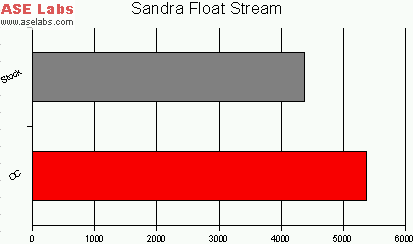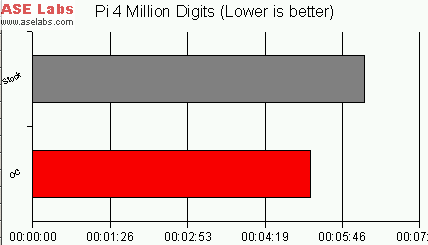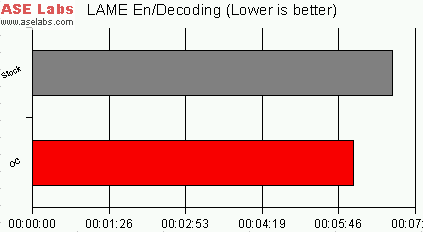Page All: Viewing All Pages
Page 1
<B>Disclaimer</B>:
I want to tell you before I start this review that <a href="http://www.crucial.com">Crucial</a> does not support overclocking, nor do they encourage it. In this review, you will see overclocked results. Crucial does not recommend this!
<B>Intro</B>:
With all the new high bandwidth CPUs from AMD and Intel, you need some pretty fast RAM to handle the higher bus speeds. There are plenty of choices and you'll want one from a reputable dealer. As it so happens, <a href="http://www.crucial.com">Crucial</a> offers PC3200 and I got the chance to test a dual 256MB for Springdale and other dual DDR boards. Dual DDR is the way to go.
<B>Dual Channel?</B>:
What are we back in the SIMMs age (no, that's not like the popular EA game)? SIMMs, or Single Inline Memory Modules were how older computers (Pentium 1s), 486s and older didn't need it (Thanks Sean!), had their memory. In those days, SIMMs had to be installed in pairs. Enough about the past, why are we getting back to requiring two sticks of RAM now? SPEED! When you have two identical sticks of RAM running in a Dual Channel Capable board, it is nearly that same as running a RAID 0 array with your memory. So (theoretically) a pair of 400Mhz Ram can instantly jump to 800 Mhz speed. Now, don't go running off to replace your old board just yet, unless you have a good and fast CPU, you won't be noticing much difference (perhaps).
<B>Crucial's Side</B>:
Here is something from Crucial, read it well!
<i>- Crucial does not support overclocking. Running Crucial memory outside of the intended specifications will void the Crucial warranty.
- Crucial is a division of Micron, we are the only memory upgrade provider selling direct from a DRAM manufacturer.
- We conduct over 95% of our transactions over the Internet. We truly use the Web to cut out the middlemen--creating efficiencies, cutting cost, boosting margins, and most of all, providing customer value.
- We are The Memory Experts (TM).</i>
<B>The box</B>:
<center>
 </center>
</center>
Crucial sends things by Fedex and it always arrives quickly. 2 day shipping is standard. The box itself is pretty sturdy. Each stick of RAM is placed in its own ESD bag and there is a manual in the back. Basically, pop the ram in and your good sort of thing. Anyone remember seeing those ads on TV?
<B>The Parts</B>:
<center> </center>
</center>
Like I said, each stick of RAM is sealed in its own ESD bag to protect it during transit. They are not taped shut, as most companies do. It is a heat seal. This further ensures the safety of the module.
<B>The RAM</B>:
<center> </center>
</center>
Each stick of RAM is PC3200 rated at CAS 3 (CL3). The voltage is at the normal 2.5v. You can clearly see the Crucial and Micron Logos on the RAM, and remember, removing those stickers voids the warranty (opps!).
<center> </center>
</center>
The back of the RAM is blank, so that means it is single sided RAM. I have found that single sided RAM is more overclockable, and more stable at higher clock speeds with less voltage. Also remember that double sided RAM has double the length of traces and modules to spread around.
<center> </center>
</center>
The module itself is a Micron chip. It better be, from Crucial (if you didn't know, Crucial is a division of Micron). The chip setup is 32x64 (meaning 8 chips with 32Mbytes each). The module is rated at 5ns which gives a speed at exactly 200mhz (400 DDR). The simple formula for determining what speed memory is rated for is by dividing the nanosecond timing from 1000. (1000/5=200). Quite simply, this means that anything over the rated speed is gray area. I would suspect people that buy Crucial memory to have a sense of stability over speed.
<B>Disclaimer</B>:
I want to tell you before I start this review that <a href="http://www.crucial.com">Crucial</a> does not support overclocking, nor do they encourage it. In this review, you will see overclocked results. Crucial does not recommend this!
<B>Intro</B>:
With all the new high bandwidth CPUs from AMD and Intel, you need some pretty fast RAM to handle the higher bus speeds. There are plenty of choices and you'll want one from a reputable dealer. As it so happens, <a href="http://www.crucial.com">Crucial</a> offers PC3200 and I got the chance to test a dual 256MB for Springdale and other dual DDR boards. Dual DDR is the way to go.
<B>Dual Channel?</B>:
What are we back in the SIMMs age (no, that's not like the popular EA game)? SIMMs, or Single Inline Memory Modules were how older computers (Pentium 1s), 486s and older didn't need it (Thanks Sean!), had their memory. In those days, SIMMs had to be installed in pairs. Enough about the past, why are we getting back to requiring two sticks of RAM now? SPEED! When you have two identical sticks of RAM running in a Dual Channel Capable board, it is nearly that same as running a RAID 0 array with your memory. So (theoretically) a pair of 400Mhz Ram can instantly jump to 800 Mhz speed. Now, don't go running off to replace your old board just yet, unless you have a good and fast CPU, you won't be noticing much difference (perhaps).
<B>Crucial's Side</B>:
Here is something from Crucial, read it well!
<i>- Crucial does not support overclocking. Running Crucial memory outside of the intended specifications will void the Crucial warranty.
- Crucial is a division of Micron, we are the only memory upgrade provider selling direct from a DRAM manufacturer.
- We conduct over 95% of our transactions over the Internet. We truly use the Web to cut out the middlemen--creating efficiencies, cutting cost, boosting margins, and most of all, providing customer value.
- We are The Memory Experts (TM).</i>
<B>The box</B>:
<center>

 </center>
</center>Crucial sends things by Fedex and it always arrives quickly. 2 day shipping is standard. The box itself is pretty sturdy. Each stick of RAM is placed in its own ESD bag and there is a manual in the back. Basically, pop the ram in and your good sort of thing. Anyone remember seeing those ads on TV?
<B>The Parts</B>:
<center>
 </center>
</center>Like I said, each stick of RAM is sealed in its own ESD bag to protect it during transit. They are not taped shut, as most companies do. It is a heat seal. This further ensures the safety of the module.
<B>The RAM</B>:
<center>
 </center>
</center>Each stick of RAM is PC3200 rated at CAS 3 (CL3). The voltage is at the normal 2.5v. You can clearly see the Crucial and Micron Logos on the RAM, and remember, removing those stickers voids the warranty (opps!).
<center>
 </center>
</center>The back of the RAM is blank, so that means it is single sided RAM. I have found that single sided RAM is more overclockable, and more stable at higher clock speeds with less voltage. Also remember that double sided RAM has double the length of traces and modules to spread around.
<center>
 </center>
</center>The module itself is a Micron chip. It better be, from Crucial (if you didn't know, Crucial is a division of Micron). The chip setup is 32x64 (meaning 8 chips with 32Mbytes each). The module is rated at 5ns which gives a speed at exactly 200mhz (400 DDR). The simple formula for determining what speed memory is rated for is by dividing the nanosecond timing from 1000. (1000/5=200). Quite simply, this means that anything over the rated speed is gray area. I would suspect people that buy Crucial memory to have a sense of stability over speed.
Page 2
<B>Testing Methodology</B>:
I'd like to start off this section by giving my feelings as to how to test RAM. I tried to isolate things that would only test the RAM, but I couldn't figure out how to really accomplish this task. The programs that I used for benchmarking were Sandra, PC Mark 2002, Super Pi, and LAME en/decoding times. If you have any suggestions on how to improve or what programs to use for testing, please let me know. Each test was run 3 times and then an average taken.
The memory was testing with an Abit IS7-E (The E means cheap!) with a 2.4C Ghz P4 with the Crucial 2x 256MB sticks.
<B>Overclocking</B>:
For stability testing, I used the excellent Memtest86, which you can <a href="http://www.memtest86">download for free</a> for your use. Overclocking this RAM was really strange.
First off, if you own an Abit Springdale or Canterwood board, don't expect to be running Game Acceleration on this, I tried it on stock speed even at 2.7V and it wouldn't even boot. I had to leave it on Auto. Also, the SPD settings are as high as you can get, and I couldn't lower it to CAS 2.5 without putting it on 2.7V, and even then it wasn't stable. I really wasn't expecting much out of this RAM.
Boy was I mistaken, I don't know if this was a fluke or not, but I got as high as 240Mhz at 2.65v running perfectly stable. Any higher and it would crap out. At 2.5v the max was 220Mhz, not bad for not increasing the voltage at all. When I set the divider to 5/4 in my BIOS, I guess my CPU was crapping out, the Max I got was 258/207 (FSB/MEM) this was the highest speed I could get on the CPU, but as I said earlier, before the RAM was running at 240/240 totally stable.
The reason I am using 258/207 is because the memory bandwidth is much better, most likely due to the extra CPU FSB bandwidth.
<B>Benchmarks</B>:
Each graph has two bars, the Gray bar shows the stock setting while the Red bar shows the overclocked setting of (258/207). The problem with some benchmarks is that the CPU speed has increased dramatically, so you might take the overclocked results with a grain of salt if you so desire.
<center>
 </center>
</center>
The first benchmarks are Sandra memory scores. The top is the integer test while the bottom is the float test. As you can see, the RAM handles pretty well without overclocking, but does gain a hefty amount of bandwidth with the increased CPU/Memory bus speed. Again, this is not using the Abit Game Acceleration technology, so it might seem low for this type of board. Both the Integer and float tests were very similar, with the stock settings pushing around 4370 MB/s and OCed at around 5390 MB/s.
<center> </center>
</center>
Next up is PC Mark 2002, from Futuremark. I used the memory score only, which was 7648 at stock and 8948 overclocked. Again we see the increase from overclocking is substantial.
The next two tests are tied into the CPU, this is partly the reason why the overclocked scores are better, you may want to just look over this section.
<center> </center>
</center>
Super PI scores, lower is better. We see the speeder CPU churning in a faster 4 million digit PI number.
<center> </center>
</center>
LAME, the MP3 encoder (or is it?) and decoder. Lower is better, I took an 107MB MP3 and converted into another MP3 file, so LAME had to decode it and then re-encode it. The faster CPU prevails.
<B>Conclusion</B>:
Crucial makes a great product at a good price. If you need stable RAM at the rated speed, look no further than Crucial for your memory needs. I have been buying from them for the past 4 years, they have to be doing something right. I'd like to thank Sadie at <a href="http://www.crucial.com">Crucial for sending this sample for review</a>!
<B>Testing Methodology</B>:
I'd like to start off this section by giving my feelings as to how to test RAM. I tried to isolate things that would only test the RAM, but I couldn't figure out how to really accomplish this task. The programs that I used for benchmarking were Sandra, PC Mark 2002, Super Pi, and LAME en/decoding times. If you have any suggestions on how to improve or what programs to use for testing, please let me know. Each test was run 3 times and then an average taken.
The memory was testing with an Abit IS7-E (The E means cheap!) with a 2.4C Ghz P4 with the Crucial 2x 256MB sticks.
<B>Overclocking</B>:
For stability testing, I used the excellent Memtest86, which you can <a href="http://www.memtest86">download for free</a> for your use. Overclocking this RAM was really strange.
First off, if you own an Abit Springdale or Canterwood board, don't expect to be running Game Acceleration on this, I tried it on stock speed even at 2.7V and it wouldn't even boot. I had to leave it on Auto. Also, the SPD settings are as high as you can get, and I couldn't lower it to CAS 2.5 without putting it on 2.7V, and even then it wasn't stable. I really wasn't expecting much out of this RAM.
Boy was I mistaken, I don't know if this was a fluke or not, but I got as high as 240Mhz at 2.65v running perfectly stable. Any higher and it would crap out. At 2.5v the max was 220Mhz, not bad for not increasing the voltage at all. When I set the divider to 5/4 in my BIOS, I guess my CPU was crapping out, the Max I got was 258/207 (FSB/MEM) this was the highest speed I could get on the CPU, but as I said earlier, before the RAM was running at 240/240 totally stable.
The reason I am using 258/207 is because the memory bandwidth is much better, most likely due to the extra CPU FSB bandwidth.
<B>Benchmarks</B>:
Each graph has two bars, the Gray bar shows the stock setting while the Red bar shows the overclocked setting of (258/207). The problem with some benchmarks is that the CPU speed has increased dramatically, so you might take the overclocked results with a grain of salt if you so desire.
<center>

 </center>
</center>The first benchmarks are Sandra memory scores. The top is the integer test while the bottom is the float test. As you can see, the RAM handles pretty well without overclocking, but does gain a hefty amount of bandwidth with the increased CPU/Memory bus speed. Again, this is not using the Abit Game Acceleration technology, so it might seem low for this type of board. Both the Integer and float tests were very similar, with the stock settings pushing around 4370 MB/s and OCed at around 5390 MB/s.
<center>
 </center>
</center>Next up is PC Mark 2002, from Futuremark. I used the memory score only, which was 7648 at stock and 8948 overclocked. Again we see the increase from overclocking is substantial.
The next two tests are tied into the CPU, this is partly the reason why the overclocked scores are better, you may want to just look over this section.
<center>
 </center>
</center>Super PI scores, lower is better. We see the speeder CPU churning in a faster 4 million digit PI number.
<center>
 </center>
</center>LAME, the MP3 encoder (or is it?) and decoder. Lower is better, I took an 107MB MP3 and converted into another MP3 file, so LAME had to decode it and then re-encode it. The faster CPU prevails.
<B>Conclusion</B>:
Crucial makes a great product at a good price. If you need stable RAM at the rated speed, look no further than Crucial for your memory needs. I have been buying from them for the past 4 years, they have to be doing something right. I'd like to thank Sadie at <a href="http://www.crucial.com">Crucial for sending this sample for review</a>!